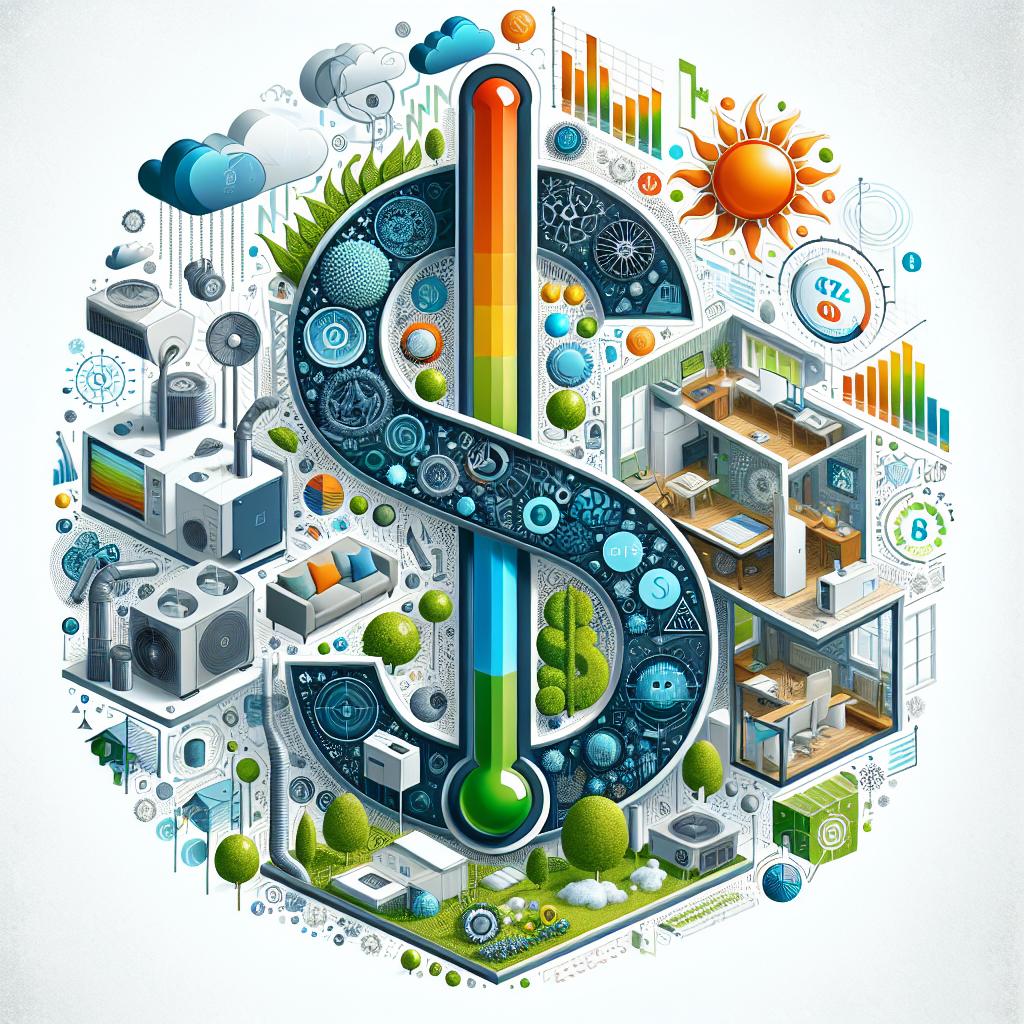In the intricate world of heating, ventilation, and air conditioning (HVAC), terminology often serves as a crucial guide through the labyrinth of technologies and systems designed to enhance our indoor comfort. Among these terms, “SEER” stands out as a pivotal benchmark that not only signifies efficiency but also shapes our understanding of energy consumption in climate control systems. So, what does SEER stand for in HVAC, and why should it matter to homeowners and industry professionals alike? In this article, we will unravel the meaning of SEER, exploring its implications for energy savings, environmental impact, and overall system performance, equipping you with the knowledge to make informed decisions about your heating and cooling needs. Join us as we delve into the essential role SEER plays in optimizing comfort while also contributing to a more sustainable future.
Understanding SEER and Its Importance in HVAC Efficiency
The Seasonal Energy Efficiency Ratio (SEER) is a critical metric to assess the efficiency of HVAC systems, particularly air conditioners. It represents the cooling output divided by the energy used during a typical cooling season. A higher SEER rating indicates greater efficiency, meaning the system uses less energy to provide the same amount of cooling. Understanding this can help consumers make informed decisions when purchasing a new system, ultimately leading to significant savings on energy bills. In the long run, opting for a unit with a higher SEER rating not only benefits the homeowner’s finances but also reduces environmental impact by lowering greenhouse gas emissions.
When shopping for HVAC systems, it’s helpful to consider the following factors related to SEER ratings:
- Cost vs. Savings: Higher SEER units may be more expensive upfront, but the reduced energy consumption can lead to substantial savings over time.
- Climate Considerations: In warmer climates, investing in a higher SEER rating can yield better returns due to increased usage during peak seasons.
- Regulatory Standards: Various regions have minimum SEER requirements established by legislation, which aim to promote energy conservation.
To illustrate the difference in efficiency, consider the following table showing average SEER ratings:
| SEER Rating | Efficiency Level |
|---|---|
| 13-14 | Minimum Efficiency |
| 15-16 | Above Average Efficiency |
| 17+ | High Efficiency |
Ultimately, understanding SEER and its implications for HVAC efficiency empowers homeowners to choose systems that align with their needs and values, prioritizing both cost-effectiveness and sustainability.

Decoding the SEER Rating: What Homeowners Need to Know
Understanding the SEER rating is essential for homeowners looking to maximize comfort while minimizing energy costs. SEER, which stands for Seasonal Energy Efficiency Ratio, indicates the efficiency of an HVAC system by measuring the cooling output during a typical cooling season divided by the energy it consumes in Watt-hours. Higher SEER ratings signify better energy efficiency, allowing homeowners not only to reduce their utility bills but also to contribute positively to environmental efforts by using less energy. Investing in a unit with a higher SEER can result in significant savings over time, especially in regions with prolonged cooling demands.
Homeowners should be aware that factors such as the size of the HVAC unit, installation quality, and the home’s insulation levels can influence the effectiveness of the SEER rating. When choosing an HVAC system, consider the following points:
- Local Climate: Hotter climates may necessitate a higher SEER for optimal performance.
- Size Matters: An improperly sized system may affect efficiency, regardless of the SEER rating.
- Long-Term Savings: Evaluate the upfront cost vs. long-term energy savings to make an informed decision.
| SEER Rating Range | Efficiency Level | Ideal for |
|---|---|---|
| 13-15 | Moderate | Temperate climates |
| 16-18 | High | Warmer regions |
| 19+ | Very High | Extreme heat areas |

Maximizing Comfort and Savings: Choosing the Right SEER Rating
When selecting a new HVAC system, understanding the Seasonal Energy Efficiency Ratio (SEER) rating is crucial for both comfort and financial considerations. A higher SEER rating indicates a more efficient unit, which translates to lower energy consumption and reduced utility bills. For optimal savings without sacrificing comfort, you might want to consider the following factors:
- Local Climate: Areas with extreme temperatures may benefit from systems with higher SEER ratings.
- Usage Patterns: If you run your HVAC system for extended periods, investing in a high SEER unit can lead to significant savings.
- Initial Cost vs. Long-Term Savings: Balance the upfront cost against the potential for energy savings over time.
To illustrate the impact of SEER ratings on energy efficiency, below is a simple comparison of common SEER ratings:
| SEER Rating | Estimated Annual Energy Cost | Typical Suitability |
|---|---|---|
| 14 | $1,100 | Moderate climates |
| 16 | $950 | Varied climates |
| 20+ | $750 | Hot climates |
By carefully considering these factors and opting for the right SEER rating, you can achieve a perfect balance of comfort and cost savings, ensuring that your HVAC investment pays off in the long run.

Future Trends in SEER Standards and Energy Efficiency in HVAC Systems
The HVAC industry is on the brink of transformation as SEER (Seasonal Energy Efficiency Ratio) standards evolve to promote even greater energy efficiency. Future trends indicate a shift towards more stringent regulations, pushing manufacturers to innovate and integrate advanced technologies such as variable-speed compressors and smart thermostats. These innovations not only enhance energy performance but also contribute to overall system longevity. Homeowners can expect to see products that not only meet but exceed current efficiency benchmarks, making energy conservation more accessible than ever.
In addition to improved technologies, we anticipate a growing emphasis on sustainability within the SEER framework. Factors influencing the future of energy efficiency standards will likely include:
- Renewable Energy Integration: HVAC systems will increasingly work in tandem with renewable energy sources, reducing overall carbon footprints.
- Smart Systems: Leveraging IoT technology to create systems that learn and adapt to usage patterns, optimizing energy consumption.
- Regulatory Changes: Anticipated government regulations could mandate higher efficiency ratings, influencing manufacturer designs.
The expected advancements pave the way for an era where energy-efficient HVAC systems not only offer improved performance but also align with global sustainability goals.
Q&A
Q&A: Understanding SEER in HVAC Systems
Q1: What does SEER stand for in HVAC systems?
A1: SEER stands for Seasonal Energy Efficiency Ratio. It’s a measure that evaluates the cooling efficiency of air conditioning systems over an entire cooling season.
Q2: How is SEER calculated?
A2: SEER is calculated by taking the total cooling output (measured in BTUs) delivered by the air conditioning unit during a typical cooling season and dividing it by the total energy consumption (measured in watt-hours) of the system during that same period. For example: SEER = Total Cooling Output (BTUs) / Total Energy Input (Watt-hours).
Q3: Why is SEER important for consumers?
A3: SEER provides consumers with a clear indicator of how energy-efficient an HVAC system is. A higher SEER rating means more efficient cooling and lower energy bills, which can lead to significant cost savings over the lifespan of the unit.
Q4: What are the minimum SEER rating requirements?
A4: The minimum SEER rating varies by region and system type. In the United States, as of 2023, residential central air conditioning systems must have a minimum SEER rating of 14 in the southern states and 13 in the northern states. However, many modern systems exceed these minimum thresholds.
Q5: Can you explain how SEER affects my utility bills?
A5: A system with a higher SEER rating will use less energy to provide the same amount of cooling as a system with a lower SEER rating. This lower energy consumption translates into reduced utility bills, making high SEER units more cost-effective in the long run.
Q6: Is a higher SEER always better?
A6: While a higher SEER rating indicates better energy efficiency, it’s essential to consider the overall cost of the unit and your specific cooling needs. Sometimes, investing in a unit with a significantly higher SEER may not provide returns that justify the initial expense, depending on your climate, usage patterns, and energy costs.
Q7: How can I improve the SEER rating of my existing HVAC system?
A7: To improve the energy efficiency of your existing HVAC system, consider regular maintenance like changing air filters, sealing ducts, and ensuring that your system is properly sized for your home. Additionally, investing in a programmable thermostat and enhancing insulation can also contribute to better energy efficiency.
Q8: Where can I find the SEER rating of my HVAC unit?
A8: The SEER rating is typically found on the unit’s nameplate or in its product specifications. If you’re unsure, you can also consult the manufacturer’s documentation or speak with a professional HVAC technician.
Q9: Are there any regulations affecting SEER ratings?
A9: Yes, there are regulations in place to encourage the use of energy-efficient appliances, including HVAC systems. The U.S. Department of Energy sets the energy efficiency standards, and these are periodically updated to reflect advancements in technology and environmental goals.
Q10: What should I consider when purchasing an HVAC system related to SEER?
A10: When purchasing an HVAC system, consider the balance between SEER rating, upfront costs, and long-term savings on energy bills. Assess your local climate, the size of your home, and how often you use your AC. Consulting with a qualified HVAC professional can help you make an informed decision that aligns with your needs and budget.
By understanding SEER and its implications, you can make informed choices that lead to comfort and efficiency in your home.
Closing Remarks
In the intricate world of HVAC systems, understanding the nuances of performance metrics like SEER can make all the difference in choosing the right air conditioning unit for your home. As we’ve explored, SEER, or Seasonal Energy Efficiency Ratio, serves as a vital benchmark for energy efficiency, helping consumers make informed decisions that benefit both their utility bills and the environment. As technology continues to evolve within the HVAC industry, staying updated on these benchmarks can empower homeowners to embrace energy-efficient solutions that not only enhance comfort but also contribute to sustainability. So, the next time you’re in the market for a cooling system, remember that SEER is not just a number—it’s your guide to smarter, greener living.

